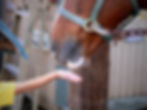Why are OTTB's so Challenging: Understanding Functionally Dysfunctional Behaviors
- Aurora Chaffee
- Mar 23, 2024
- 4 min read
Updated: Apr 23
Functional dysfunction: What does THAT mean?
Functional: of or having a special activity, purpose, or task; relating to the way in which something works or operates.
dysfunction: abnormality or impairment in the function of a specified bodily organ or system
In other words, a functional dysfunction is an activity your horse performs that serves the purpose of expressing an impairment of function in the system.
It is a way that your horse expresses internal discomfort and tension within the body, but is socially acceptable to the environment (you) around him/her.
What does this look like in a horse?
When a horse is given true, honest space and time with no demands or expectations, this is the behavior/actions/mentality they display as a replacement for true relaxation/rest behaviors.
This usually manifests as:
Distractibility
Fidgetiness
Mouthiness towards you or the lead rope
Pawing
Oral fixations
Shutdown behavior: Appearance of being at rest without evidence of relaxation.
dull eyes, dull expression.
Consistent need to move.
Constant need for entertainment.
A horse only needs to show one of these behaviors repeatedly to be evidence of functional dysfunction.

I work with many horses and many breeds that have functional dysfunctions. These patterns don't break the boundaries entirely for the human they're just a little annoying, like a gnat buzzing near your ear.
Imagine you are having a conversation with a friend or trainer and your horse is standing next to you but constantly nibbling on your hand or your jacket, at times you think it's cute but sometimes push their head a way. At some point the nibbling turns into a bite and it hurts and you smack your horse or get mad at them for being in your space.
For a moment, your horse is frozen from the experience and still, but eventually they start to creep back into your space and start nibbling on your jacket/hands/lead rope again. See the pattern?
So what is a FUNCTIONAL behavior?
When a horse's behavior is functional, at times of rest on the lead rope or under saddle, there body enters a state of relaxation and rest; its true comfort and peace within themselves and with their environment.
A relaxed horse is comfortable within themselves and their environment. While every horse knows HOW to relax when taking a nap or laying down to sleep, this is not a tool they are aware of when entering our manufactured environment.
How do you know if your horse if functionally relaxing?
Here are some way to evaluate if your horse is relaxing functionally:
When given no task or distractions, how does the horse handle standing with you?
What is the duration of time it takes for them to start showing signs of rest/relaxation? Duration in between deepening the relaxation?
What is the duration of time in between dysfunctional behaviors?
Does the human demonstrate relaxation at rest for the horse to resonate off of, or does the human have a fidgetiness and buzz of energy about them?
Does your horse bounce between dyfunctional functional behaviors and relaxation behaviors but never seems to fully "relax"?
Things to look for when your horses relaxation system is functioning properly:
Breathing a sigh
Snorting out
Stretching
Shaking/releasing of the neck
Lowering the head
Blinking (two or three times in a row)
Farting
Licking
Chewing
Relaxed lower lip, sleepy
Softening look in the eyes and facial expression
Increased moisture of the mouth
Twitching of the ears
Directing one ear towards the human

To be frank, horses live in OUR world. They're not roaming endless miles of prairie with their herdmates. From a young age, horses learn to operate and survive in the world/environment we place them in. There are going to be learned behaviors that help them cope and survive the strange demands and expectations placed upon them.
Functional dysfunctions are evidence of held tension in the horse's mind and body that they do not have the tools to process and release.
It is our role to identify these and replace them with functional tools that will help the horse thrive in their environment.
If you are seeing/experiencing functional dysfunction in your horse, that is indicator for you that your horse is experiencing internal tension and distress.

I'll be honest, I have clients that discontinue sessions because as we uncover the functional dysfunction what's going on under the surface makes them uncomfortable. They'd rather continue to live with the mask that they're horse is just expressive or overly affectionate, or not shutdown but just resting. That is why it's functional for them!
My favorite partners are the ones that embace curiosity, and strive for their horses to reflect their truest selves even though it's uncomfortable! These clients need to have a level of self-awareness and compassion for their horses to seek and find their horse's truest, happiest, healthiest self.
I recognize this blog post might ruffle some feathers. If if your feathers are ruffled as this point, Acknowledge-Accept-Allow those feelings. Choose curiosity as to why the recognition of dysfunction in your horse feels like a threat to you.
This is the most foundational layer for building or rebuilding a strong partnership with your horse. If you want help replacing functional dysfunctions with you and your horse, I've have so many tools and pathway to help you through this!
If you want a guide to uncover and resolve these dysfunctional behaviors, I highly recommend the Restart Online Program. This is an easy to follow step-by-step approach to resetting a new (functional) foundation and rebuild towards your goals in harmony with your OTT partner.
Happy Partnerships and stay curious!

